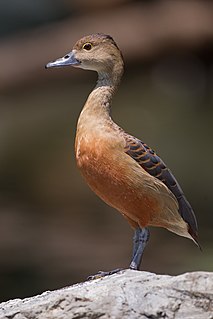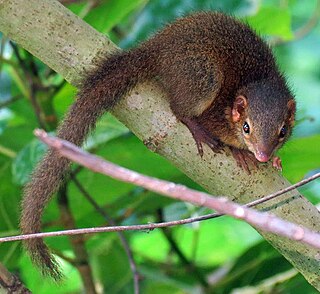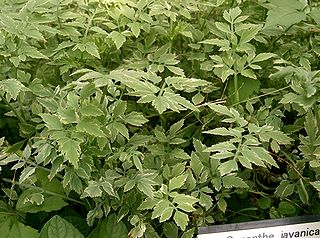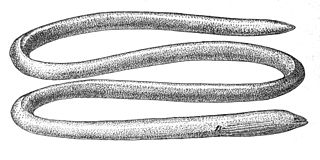
The lesser whistling duck, also known as Indian whistling duck or lesser whistling teal, is a species of whistling duck that breeds in the Indian subcontinent and Southeast Asia. They are nocturnal feeders that during the day may be found in flocks around lakes and wet paddy fields. They can perch on trees and sometimes build their nest in the hollow of a tree. This brown and long-necked duck has broad wings that are visible in flight and produces a loud two-note wheezy call. It has a chestnut rump, differentiating it from its larger relative, the fulvous whistling duck, which has a creamy white rump.

In astronomy, metallicity is the abundance of elements present in an object that are heavier than hydrogen or helium. Most of the physical matter in the Universe is in the form of hydrogen and helium, so astronomers use the word "metals" as a convenient short term for "all elements except hydrogen and helium". This usage is distinct from the usual physical definition of a solid metal. For example, stars and nebulae with relatively high abundances of carbon, nitrogen, oxygen, and neon are called "metal-rich" in astrophysical terms, even though those elements are non-metals in chemistry.

Castanopsis, commonly called chinquapin or chinkapin, is a genus of evergreen trees belonging to the beech family, Fagaceae. The genus contains about 120 species, which are today restricted to tropical and subtropical eastern Asia. A total of 58 species are native to China, with 30 endemic; the other species occur further south, through Indochina to Indonesia, mountainous areas of Taiwan, and also in Japan. The English name chinkapin is shared with other related plants, including the golden chinkapins of the Pacific United States, which are sometimes included within Castanopsis but are more often considered a separate but very closely related genus, Chrysolepis.

Root-knot nematodes are plant-parasitic nematodes from the genus Meloidogyne. They exist in soil in areas with hot climates or short winters. About 2000 plants worldwide are susceptible to infection by root-knot nematodes and they cause approximately 5% of global crop loss. Root-knot nematode larvae infect plant roots, causing the development of root-knot galls that drain the plant's photosynthate and nutrients. Infection of young plants may be lethal, while infection of mature plants causes decreased yield.

Cicindela, commonly known as common tiger beetles are generally brightly colored and metallic beetles, often with some sort of patterning of ivory or cream-colored markings. They are most abundant and diverse in habitats very often near bodies of water with sandy or occasionally clay soils; they can be found along rivers, sea and lake shores, sand dunes, around dry lakebeds, on clay banks, or woodland paths.
Meloidogyne javanica is a species of plant-pathogenic nematodes. It is one of the tropical root-knot nematodes and a major agricultural pest in many countries. It has many hosts. Meloidogyne javanica reproduces by obligatory mitotic parthenogenesis (apomixis).

Horsfield's treeshrew, also called Javan treeshrew, is a treeshrew species within the Tupaiidae. It is endemic to the Indonesian islands of Sumatra, Bali, Java and Nias where it inhabits foremost primary forest.

Aerva javanica, the kapok bush or desert cotton, is a species of plant in the family Amaranthaceae. It has a native distribution incorporating much of Africa, and the south-west and south of Asia, and it has become adventitious in northern Australia.

Japonica rice, sometimes called sinica rice, is one of the two major domestic varieties of Asian rice. Japonica rice is extensively cultivated and consumed in China, Japan, Korea, whereas in most other regions Indica rice is the dominant type of rice.

Oenanthe javanica, commonly Java waterdropwort, Chinese celery, Indian pennywort, Japanese parsley, water celery, water dropwort and minari, is a plant of the water dropwort genus originating from East Asia.. It has a widespread native distribution in temperate Asia and tropical Asia, and is also native to Queensland, Australia.

Sambucus javanica, the Chinese elder, is a species of elderberry in the family Adoxaceae native to subtropical and tropical Asia. It is found naturally in Bhutan, Burma, Cambodia, China, India, Indonesia, Japan, Laos, Malaysia, the Philippines, southern Thailand, and Vietnam. It is a perennial herb or a small shrub 1–2 m tall.

Cyphogastra is a genus of beetles in the family Buprestidae, containing the following species:

Cassia javanica, also known as Java cassia, pink shower, apple blossom tree and rainbow shower tree, is a species of tree in the family Fabaceae. Its origin is in Southeast Asia, but it has been extensively grown in tropical areas worldwide as a garden tree owing to its beautiful crimson and pink flower bunches.

Cyphogastra calepyga is a Jewel Beetle of the Buprestidae family.

The Java spaghetti eel, also known as the Java thrush-eel, Java worm eel, and the black-tailed thrush eel is an eel in the family Moringuidae. It was described by Johann Jakob Kaup in 1856, originally under the genus Aphthalmichthys. It is a tropical, marine eel which is known from the Indo-Pacific, including East Africa, the Tuamoto Islands, the Ryukyu Islands, and Micronesia. It is a burrowing species which inhabits reefs at a depth range of 2–15 m. Males can reach a maximum total length of 120 cm.
Filopaludina javanica or Idiopoma javanica is a species of large freshwater snail with a gill and an operculum, an aquatic gastropod mollusk in the family Viviparidae.

Brucea javanica is a shrub in the family Simaroubaceae. The specific epithet javanica is from the Latin, meaning "of Java". Other common names in English include Java brucea and kosam.
Picrasma javanica is a tree in the family Simaroubaceae. The specific epithet javanica is from the Latin meaning "of Java".
Castanopsis javanica, the Javan chestnut-oak, is a tree in the beech family Fagaceae. The specific epithet javanica is from the Latin, meaning "of Java".

Cupang is a barangay in the Muntinlupa, Philippines. The total land area of the barangay is 5.370 km2. It has a population of 57,013. It is located in the Northern section of the city.
















